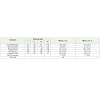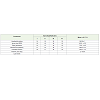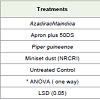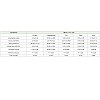Research Article
Post Harvest Studies on Yam Tubers Dioscorea rotundata Poir. Pre-Treated With Bio- Pesticides against Soil Pests and Pathogen
Aghale DN1*, Umeh OJ2 and Onyenobi FI3
1Michael Okpara University of Agriculture, Umudike, Nigeria
2Michael Okpara University of Agriculture, Umudike, Nigeria
3Abia State University, Uturu, Nigeria
Corresponding author: Aghale, Duke Nduka, Michael Okpara University of Agriculture, Umudike, Nigeria, Tel No:08134005735; E-mail: aghalenduka@yahoo.com
Citation: Aghale DN, Umeh OJ, Onyenobi FI. Post Harvest Studies on Yam Tubers Dioscorea rotundata Poir. Pre-Treated With Bio- Pesticides against Soil Pests and Pathogen. J Plant Sci Res. 2016;3(1): 146.
Copyright © 2016 Aghale, Duke Nduka, et al. This is an open access article distributed under the Creative Commons Attribution License, which permits unrestricted use, distribution, and reproduction in any medium, provided the original work is properly cited.
Journal of Plant Science & Research | ISSN: 2349-2805 | Volume: 3, Issue: 1
Submission: 07/04/2016; Accepted: 30/04/2016; Published: 07/05/2016
Abstract
Post-harvest loses has been the bane of yam farmers over the years negating effort, resources and time invested in crop production. Farmers need to be equipped with pesticide alternatives for yam minisett seed dressing that are affordable, available, non-toxic to man and environmentally friendly. Postharvest investigation was conducted on yam tubers harvested from field planted with minisett yams Dioscorea rotundata cv abii pre-treated with fruit powder of Azadirachta indica and Piper guineense in comparism with Apon plus 50DS and Minisett dust (NRCRI) as seed dressing at 2.7kg/ha against soil pests and pathogens. The germination / sprouting of the yam tubers was not significantly (P>0.05) affected by the bio- pesticides. At 16 weeks in storage, all thetreatments except Minisett dust significantly controlled or reduced weight loss of yam tubers. The treatments significantly controlled yam rot while Piper guineense performed best. Nematode infestation (root knot galled tuber and Scutellonem bradys cracks) on yam tubers was effectively controlled (by Piper guineense, Azadirachta indica followed by Apron plus 50DS and Minisett dust treatment. Storage insects Araecerus fasciculatus Degeer and (Coleoptera Anthribidae) attacked all pre-treated and untreated (control) tubers in storage. Analysis of the yam tuber nutrient composition showed no significant differencein carbohydrate, protein, fat ash, and fiber contents compared with the composition of the untreated tubers (control). Apron plus treatment however, appeared to lower protein content of yam tubers and the yam tissue of Dioscrea rotundata cv abii. The study concluded that the use of A. indica and P. guineense fruit dust as seed treatment will encourage shelve life and higher production of seed yams which will affect the market value of planting materials positively. Therefore it is recommended for wide spread farmers awareness and use through extension advocacy.
Keywords: Bio-pesticides; Yam mini-sett; Nematodes; Insects; Agricultural Extension
Introduction
Yam (Dioscorea spp.) is the major agriculture crop in Nigeriathat represents about 75% of West Africa’s production [1]. It is thepreferred home - grown food of the 100 million Nigerians [2]. WareYam and Yam minisett technology are among the key packagesdisseminated by Agricultural Development Programme (ADP) fieldextension agents which have met with low adoption rate due to croploss to pest and diseases among others [3]. Furthermore, the cost of yam production is prohibitive due to the cost of seed yams. The new minisett technology has reduced cost considerably [4]. Macro seed yam production by minisett technology has been estimated to give a commercial grower an annual profit of £7,000-13,500/ha [4]. Pests and pathogens flourish in tropical soils and without pesticide treatments, the minisetts, will completely decay in the soil [5].
Substantial losses due to infestations by plant parasitic nematodesand other soil pests and pathogens during cultivation and subsequent rot in storage due to complex disease syndrome of nematodes/ fungi/bacteria and viruses have been reported by several investigators [6-8,5,1] Several commercial pesticides have been evaluated for their efficacy as seed dressing materials for the control of soil pests and pathogens with subsequent effect on the quantity and quality of yamtubers at harvest and also in storage with promising results [9]. A study by World Health Organization (WHO) in1972 estimated 500,000 annual pesticide poisoning globally with about 5,000 deaths Farah, 1994) thus highlighting dangers of some synthetic pesticides in Agriculture [10].
The most common pesticides readily available and fairlyaffordable by most farmers are the organ chlorines such as Aldrex T (acombination of 30% Aldrin, a cyclodiene and fungicide thiram) [11]. Due to toxicological reasons, the pesticide mainly organochlorines have been banned on food crops in developed countries [12,10].
There is a need therefore to search for pesticide alternatives foryam minisett seed dressing that are affordable available non - toxic toman and are environmentally friendly [13]. This study was designedto evaluate the effects of ethno-medicinal plants (natural products)treatment on yam minisetts pre-treated in field and on the harvestedmacro seed yams in storage.
Materials and Methods
Post-harvested studies were conducted on yam tubers (Dioscorearotundata cv abii) pretreated at cultivation in the field with Azadirachta indica and Piper guineense (fruit powder). Minisett dust (NRCRI) (from National Root Crops Research Institute, Umudike and Apronplus 50DS (a standard insecticide/fungicides) to control soil pestsand pathogen. The treatments were applied as seed dressing duston Minisetts yam tuber at 2.7kg/ha. And were replicated four timeswith 20 minisetts per replicate. The field was arranged in four fully randomized blocks with one replicate of each treatment per block.Each block measured 6 x 5m (made up of 5 ridges 6m in length with1m between blocks). Discard ridges surrounded the experimental netplots. After normal cultural practices (staking weeding and fertilizerapplication at the appropriate times) the yam tubers were harvestedafter 28 weeks.
The harvested tubers were stored in an improvised wellventilatedbarn where the yams were placed on horizontal racks.The temperature in the barn was monitored with a maximum andminimum thermometer and relative humidity measurements takenusing a whirling hygrometer. The minimum temperature duringthe period of study ranged from 22.7-28.7 °C, while the maximumtemperature ranged from 30.7-36.6 °C the relative humidity at 9.00-1.000h ranged between 78 and 85% and at 15.00-16.00 between 50and 75%.
The investigation was conducted after 16 weeks in storage on theeffect of treatments on yam tubers in parameter:
i. Weight Loss of yam tubers.
ii. Sprouting/Germination of yam tubers.
iii. Pests and pathogens infestation and yam rot.
iv. Nutrient/Composition of yam tubers.
i. Total weight loss of yam tubers (Table 1): Y a m tubers for the study were randomly selected from each treatment anduntreated control. (Each replicate of 10 yam tubers) After 16 weeksin storage, the yam tubers from each treatment and untreated controlwere weighed and the percentage weight loss calculated.
Table 1: Effect of bio - pesticide treatments at cultivation on weight loss of yam tubers after 16 (sixteen weeks) in storage.
Wt of yam tubers at harvest - Wt of yam tubers after 16weeks X 100, Weight of yams at harvest
ii. Sprouting/Germination (Table 2))
Four replicates of five tubers (4x5 = 20 ) were randomly selectedfrom each treatment and the untreated control. Sprouting of the yamtubers were taken after 14 weeks in storage when dormancy musthave been broken.
Table 2: Effect of bio and synthetic pesticide treatments on the sprouting/germination of D. rotundata cv abii after 14 (fourteen) weeks in storage.
iii. Pests infestation and rot diseases in storage (Table 3)
a. Nematode infestation at harvest was not apparent. After 16weeks in storage, galls were apparent indicating rook-knot nematodeinfestation. The galled tubers were counted and recorded for eachtreatment and the untreated control.
Table 3: Effects of bio and synthetic pesticide treatments on: pests, pathogens and rot/bio deterioration of D. rotundata CV abii in storage, after 16 weeks.
b. Insect infestation
The total numbers of adult insects found on the yam tuberswere counted after 16 weeks and recorded for each treatmentand untreated control. The main insects found were identified asAraecerus fasciculatus Degeer (Coleoptera: Anthribidae). (A yamstorage insect).
c. Yam rot (complex disease syndrome of micro-organisms).Total number of yam tubers affected by rot disease were counted foreach treatment and the untreated control and recorded.
(iv). Yam tuber composition (Table 4)
Analysis of yam composition of treated and untreated yam tuber sample were conducted for protein, carbohydrate, fat, ash and fibercontents at the Food Science/Biochemistry Laboratory at NationalRoot Crop Research Institute (NRCRI) Umudike.
Table 4: Effect of bio and synthetic bio pesticide treatments on yam D. rotundata cv abii composition after 16 (sixteen) weeks storage.
Results and Discussion
Effects of Treatment on Weight loss of yam tubers (Table 1).
After sixteen weeks in storage, tubers treated with Azadirachtaindica, Piper guineense and Apron plus significantly controlled weightloss (p < 0.05) when compared with the untreated control. There wasno statistically significant difference (p > 0.05) between yam tuberweight losses of treatment with Minisett dust (NRCRI).
(ii) Effect of Treatments on Sprouting (Germination) of yamtubers (Table 2).
After 14 (fourteen) weeks in storage, the effect of all thetreatments showed no significant difference (p > 0.05) on sproutingof yam tubers compared with the untreated control. Piper guineensetreatment appeared to inhibit germination while Apron plus 50DStreatment appeared to stimulate sprouting.
(iii) Post-harvest Pest and pathogen infestation and yamtuber rot (Table 3).
Azadirachta indica, Piper guineense, and Apron plus 50 DStreatment significantly controlled the rate of insect attack on all treatments compared with the untreated control. There was nosignificant difference (p> 0.05) on the rate of insect attack on alltreatment compared with the untreated control. Apron plus 50DSwas the best in insect control. Azadirachta indica, Piper guineense,Apron plus and Minisett dust significantly controlled nematodeinfestations as indicated by galls (root-knot nematodes) and crackswith (Scutellonem abradys).
(iv) Effect of Treatments on yam tuber composition (Table 4).
Treatments of Azadirachta indica, Piper guineense, Minisett dusthad no significant different effect (p > 0.05) on the carbohydrate,protein fat, and ash fiber contents of yam tubers. Protein content ofyam tubers treated with apron of 50DS was lower than that of othertreatments and untreated control.
Discussion
The objective of this research is to evaluate the effectiveness ofbiologically-based and environmentally safe natural products asalternative control methods for soil borne pests and pathogens, toreplace toxicologically dangerous organochlorines such as methylbromide, Aldrex T and carbonate carbofuran in yam protection,during cultivation and storage.
Coursey reported that nearly 50% of yam tubers were oftenlost after six months in storage due to yam metabolic processes(respiration and transpiration) and/or pest and pathogen infestation[14]. In this study the natural products controlled weight loss bydirectly controlling pests and pathogen activities.
After dormancy (a physiological rest period? yam tuber duringwhich sprouting is suppressed), sprouting or germination starts.Sprouting can be inhibited in storage to prolong dormancy withgibberellin or stimulated with naphthalene acetic acid (NAA), [15].
Yam tuber treatments at 4 week in storage had no statisticallysignificant difference (P>0.05) on sprouting. However, Onyenobi,et al., (in press) observed that Piper guineense treatments appearedto inhibit yam set sprouting after four weeks in storage comparedwith other natural product treatments. In this study, Piper guineenseappeared to inhibit sprouting. P. guineense treatment proved veryeffective in the control of nematode infestation and yam bio -deterioration followed by Apron plus 50DS and Azadirachta indica.Onyenobi et al.,( in press) reported that A. indica and P. guineenseleaf extract reasonably controlled bio-deterioration of yam tubersinduced by root knot nematodes during storage, which furtherconfirms the efficacy of these natural products in the control of yamrot disease.
Insect groups responsible for bio- deterioration of yam tubersin storage are Coleoptera (beetle) and Lepidoptera (moths andbutterflies), [16]. Araecerus fasciculatus Degeer (Coleoteran ;Anthribidae) attacked the yam tubers in storage despite the treatmentapplication. Possibly the natural products degraded to non- toxicconcentrations hence the lose of effectiveness. The synthetic pesticideApron plus50DS appeared to control insect infestation in storagebest.
Conclusion
The biologically based natural products had no deleterious effects on the yam tuber composition (protein carbohydrate fat ash, andfiber). Apron plus 50DS appeared to reduce the protein content of the yam tubers and also gave a pink coloration, Pesticides constituteenvironmental problems and the recent analysis by an Environmentalprotection Agency reported that mortality rates estimates that theuse of pesticides carbofuranalone has resulted in 1-2 million deathsin birds in United States of America annually, including someendangered and threatened birds [17]. A. indica and P. guineense areused for ethno medicinal practices and as food spices in Nigeria. Theyare readily available affordable accessible and non-toxic to man andthe environment. They are easily propagated and produced, also couldbe encouraged as seed dressing bio-pesticides in crop production andstorage treatments.
Recommendations: The use of A. indica and P. guineense fruitdust as seed treatment will increase shelve life and production ofseed yams which will affect the market value of planting materialspositively. Therefore it is recommended for wide spread farmersawareness and use through extension advocacy.
References
- FAO (1993) FAO yearbook, FAO Rome Italy: 95.
- Adesiyan SO (1995) Studies on the infection of yams by Scutellonema bradys(steiner Lettew).
- Umeh OJ (2016) Comparative Performance Evaluation of the State ADPs in Nigeria. (Effective Extension Delivery Services). Lambert Academic Publishing. USA. Pp 160-167.
- IITA (1995) Annual Report for 1995 (International Institute of Tropical Agriculture, Ibadan, Nigeria.
- Onyenobi F, Ieoma (1986) Chemical control of Meloidogyne species (Nematoda) in yam (Dioscorea rotundata Poir.) production. Ph. D thesis of Imperial College London. (University of London) 262p.
- Okafor N (1966) Microbial rotting of stored yams (Dioscorea spp) in Nigeria. Exptl Agric 2: 178-182.
- Bridge J (1972) Nematode problems with yams (Dioscorea spp. ) in Nigeria. PANS 18: 89-91.
- Bridge J (1973) Nematodes as pest of yam in Nigeria. (scutellonema bradys, Pratylenchus).
- Onyenobi F, Ijeoma (1993) Evaluation of commercial pesticides for protection of Dioscorea rotundata from Meloidogyne incognita at cultivation. Advances in Yam Research 2: 34-41.
- IRPTC (1994) Progress in implementation of the FAO/UNEP joint Programme on prior informed consent. Journal of the International Register of potentionally Toxic Chemicals devoted to information of hazardous chemicals 12: 8.
- Onyenobi F, Ijeoma (1996) Pesticide Use and Misuse in Nigeria Fasmen Communication Okigwe Nigeria. ISBN 961-2362-68-5.
- Visweswariah K, Jayaram M, Majumder SK (1975) Environmental pollution with pesticides. Journal of Food Science and Technology 2: 53-60.
- BOSTID (1992) National Research Council; NEEM, a tree for solving global problems. Brachyuru sMeloidogynincognita, Rotylenchus reniformis). Meded Fac. Landbouwet. Riika University Gent. 38: 841-852.
- Coursey DG (1967) Post- harvest problems of yam. Paper presented to 1st International????.
- IITA (1986) Annual Report for 1986 (IITA) Ibadan. Nigeria.
- Okwor GC, Asiedu R, Ekanayaka IJ (1998) Food yams. Advances in Research.
- Hoppin PR, Liroff A, Miller MM (1997) Reducing reliance on pesticides in Great Lakes Basin Agriculture. Washinton D.C; world Wildlife Fund.




